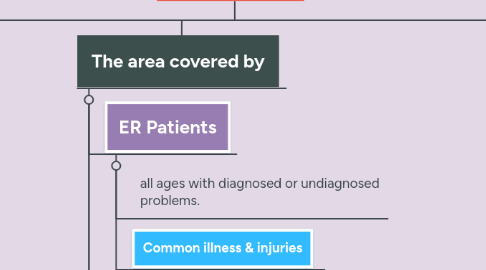
1. Specialty
1.1. Interventions minimal to life-saving.
1.2. prevention is an integral part of ER.
1.3. Lifespan in a variety of patient care settings.
1.4. ER nursing practice.
2. Characteristics of ER nursing practice
2.1. Nursing process.
2.2. Triage & prioritization.
2.3. ER operations preparedness.
2.4. Stabilization & resuscitation.
2.5. Crisis intervention for PT populations (sexual assault survivors).
2.6. Provision of care in uncontrolled environment.
2.7. Renal problems.
2.8. Consistency across the continuum of care.
3. The area covered by
3.1. ER Patients
3.1.1. all ages with diagnosed or undiagnosed problems.
3.1.2. Common illness & injuries
3.1.2.1. 1. Injuries
3.1.2.1.1. Traumatic.
3.1.2.1.2. Orthopedic.
3.1.2.1.3. Violence & abuse.
3.1.2.2. 2. Medical
3.1.2.2.1. Cardiovascular(chest pain/MI).
3.1.2.2.2. Respiratory (Asthma/Pulmonary embolism/respiratory failure).
3.1.2.2.3. Hypovolemic shock.
3.1.2.3. 3. Surgical
3.1.2.3.1. Gastrointestinal & hepatic.
3.1.2.4. 4. Other
3.1.2.4.1. Paediatric problem.
3.1.2.4.2. Drug over dose.
3.1.2.4.3. Obstetric problems.
3.1.2.4.4. Psychiatric.
3.2. ER nurses
3.2.1. Vigilant.
3.2.2. Critical thinker.
3.2.3. Details oriented.
3.2.4. Ability to collaborate effectively with pre-hospital care provider.
3.2.5. Team collaboration.
3.2.6. Masters technology & equipment.
3.2.7. Knowledgeable and apply the nursing process.
3.2.8. Consultation timely.
3.3. Environment
3.3.1. Unpredictable numbers of PTs.
3.3.2. Unknown PT variables(severity, urgency, diagnosis).
3.3.3. Unanticipated situations requiring interventions.
3.3.4. Allocation of limited resources.
3.3.5. Need for immediate care.
3.3.6. Contextual factors.
4. Issues
4.1. Documentation of consent.
4.2. Limiting exposure to the health risks.
4.3. Violence.
4.4. Providing holistic care
5. Nursing interventions
5.1. Patient-focused interventions
5.1.1. 1. Act confidently & competently promote a sense of security.
5.1.2. 2. Provide human contact&reassuring words.
5.1.3. 3. Provide adequate explanations.
5.1.4. 4. The unconscious patient should be touched, called by name, & given an explanation of every procedure that is performed.
5.1.5. 5. Orient patient frequently in an appropriate manner.
5.2. Family-focused interventions
5.2.1. 1. Inform family about the details related to PT condition.
5.2.2. 2. Allow family to stay with PT when possible.
5.2.3. 3. Provide additional interventions based on assessment of the stage of crisis.
5.2.4. 4. Provide measures to help family members cope with sudden death.

